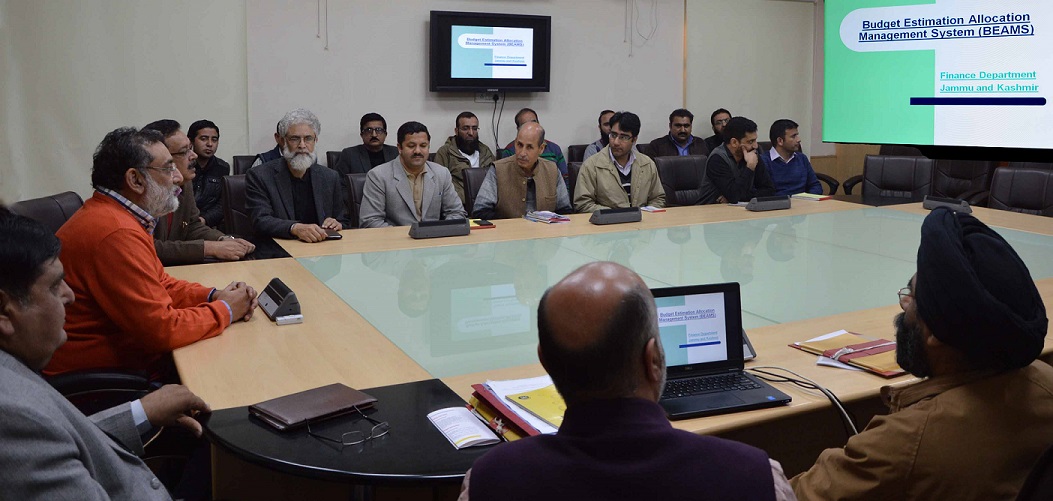Dr Drabu launches Online Budgeting Portal – BEAMS; Rs 35000 cr released for fiscal 2017-18 beforehand
JAMMU: For the first time in the State’s fiscal history, the Finance Department today released, well ahead of schedule, 50% of the budgetary allocation to the tune of around Rs 35000 crore for the financial year 2017-18 for developmental and other activities.
The path-breaking initiative would facilitate the Government Departments to set into motion the developmental process for the next fiscal well in advance. Earlier, the budgetary allocation used to be released by the Finance Department with the beginning of the new financial year in April while the Administrative Departments used to pass it on to the line departments in July-August resulting in developmental deficit because of limited working season available in various parts of the State.
The new and proficient online system of resource allocation was today formally put in place by the Finance Minister, Dr Haseeb Drabu with the launch of a robust, quicker, transparent and efficient computerized mechanism – BEAMS (Budget Estimation, Allocation and Monitoring System).
“We have today released around half of the total budgetary allocation of Rs 80000 crore for the fiscal 2017-18 to the Administrative Secretaries through BEAMS and they will have to pass it on to the field Departments by 20th February 2017,” Dr Drabu said at the launch of the new system of fund allocation. He said it includes both revenue and Capex allocation.
Financial Commissioner Planning, Development & Monitoring, B B Vyas, Commissioner Secretary Finance, Navin Kumar Choudhary, Director General Budget, M I Wani, Director Budget, Imtiyaz Ahmad, Director Perspective Planning, Shahzada Bilal Ahmad and other officers of the Finance and Planning Departments were present on the occasion.
Enumerating on the new system, Dr Drabu said, BEAMS is an online computerized system to distribute the budget and to authorize expenditure thus reducing the old time-consuming manual practice. “The process of budgeting, releasing and distribution of resources was till date done manually which was a time consuming process beset with difficulty in monitoring and non-availability of data for decision making in real time basis resulting in either non-utilization of funds or their misclassification at times,” he said.
The Minister said with the introduction of BEAMS, once the budget is released, the departments can allocate funds to their executing agencies through the system and thereafter all the expenditures will not only be regularly checked for budget availability but will also control monthly cash flows against pre-determined targets.
To ensure that a prompt and sustainable mechanism is put in place for devolution of resources for development, Dr Drabu said, the Administrative Secretaries shall have to mandatorily release the funds to the respective field departments by 20th February 2017 failing which it would be deemed that the funds stand automatically released to the concerned line departments. He said while the Chief Minister, the Finance Minister and the Finance Secretary shall, through a dedicated user ID, will regularly monitor the quantum and progress of allocations online, the Administrative Secretaries shall have their own user ID to access the BEAMS and hand out the allocations to the concerned line departments in time-bound manner.
“The Finance Department is in the process of creating individual user IDs for all the Ministers and by April 2018 all of them will be having access to BEAMS to monitor the progress of funds allocation in their respective Departments,” he said.
Dr Drabu said BEAMS permits re-appropriation of funds within the prescribed limits and allows withdrawal/surrender of allocation and it will provide limited facility to modify cash flows. He said MIS section gives various reports on budget authorization, cash flow, fund transfer transactions and will generate authorization slips. He said during Budget Estimation, the DDOs will prepare the budget requirements on BEAMS and forward to the Budget Controlling Officer (BCO) who will compile the estimates and forward it to the Budget Controlling Authority. He said later the Heads of Departments will compile the estimates online and forward it to the administrative secretaries for final submission to Finance Department.
He said during Budget Distribution process the Finance Department will use the same online channel to release the Budget to the Departments through Administrative Secretaries up to the DDOs level He said the BEAMS is a centralized database connected on real time basis with Budget Control and Monitoring facility.
Pertinently, Dr Drabu had in his Budget speech in the State Legislature last month announced that 50% of the budgetary allocation for the year 2017-18 would be released by 10th February 2017 to ensure that the developmental process is not hampered for want of resources.
For the fiscal 2017-18, the state government proposes to spend Rs 79472 crore of which Rs 31000 crore (39%) is expected to be spent on developmental activities while 12% each will go to ‘other expenditure’ and power purchase, 25% to wages and salaries and 6% each to interest payment and employee pensions.
“BEAMS has been launched with the sole objective of effectively utilizing and monitoring the highest ever allocation for developmental activities in the State in a fiscal year,” Dr Drabu said and added that the increase in the budgeted Capex has massively shifted the total percentage of expenditure on development front. “In 2011-12, the rate of investment was 6.80 percent of the State Domestic Product which has reached 10.02 percent in 2016-17, the highest ever,” he said.
Drabu said the main focus in 2017-18 will be on timely rollout of projects under Prime Minister’s Development Package (PMDP) of Rs 80,000 crore for development and reconstruction of physical and economic infrastructure. The package caters to the need to strengthen the economic and social infrastructure and provide for the balanced development of the three regions of J&K.


